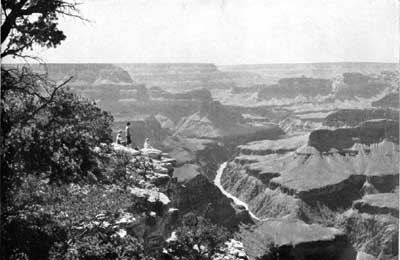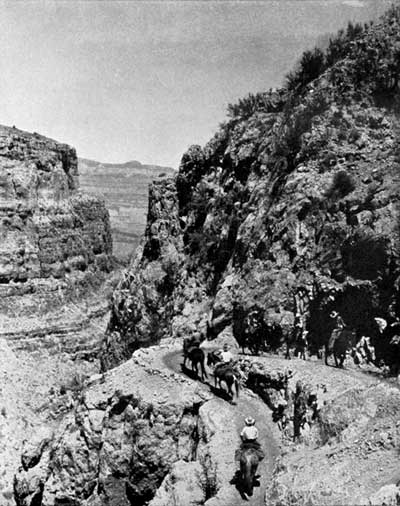MENU
![]() Grand Canyon
Grand Canyon
 XVI
XVI

THE GRAND CANYON NATIONAL PARK
ARIZONA
Special Characteristic: A Highly Colored, Mile-Deep Gorge, 4 to 18 Miles Across; 105 of Its 217 Miles of Length Within the Park
 View from between Mojave Point and Pima Point—Grand Canyon National Park |
THE rain falling in the plowed field forms rivulets in the furrows. The rivulets unite in a muddy torrent in the roadside gutter. With succeeding showers the gutter wears an ever-deepening channel in the soft soil. With the passing season the gutter becomes a gully. Here and there, in places, its banks undermine and fall in. Here and there the rivulets from the field wear tiny tributary gullies. Between the breaks in the banks and the tributaries, irregular masses of earth remain standing, sometimes resembling mimic cliffs, sometimes washed and worn into mimic peaks and spires.
Such roadside erosion is familiar to us all. A hundred times we have idly noted the fantastic water-carved walls and minaretted slopes of these ditches. But seldom, perhaps, have we realized that the muddy roadside ditch and the world-famous Grand Canyon of the Colorado are, from nature's standpoint, identical; that they differ only in soil and size.
The arid States of our great Southwest constitute an enormous plateau or tableland from 4,000 to 8,000 feet above sea level. It is a plateau of sun-baked conglomerate and loose soils from which emerge occasional mountain masses of more or less solid rock. Rain seldom falls, but in winter the snows lie heavy in the mountains. In the spring the snows melt and torrents of water wear temporary beds in the loose soils.
In ages before history the Colorado River, like the roadside ditch, started gradually digging the ever-deepening channel that now cuts this tableland. In time, as with the roadside ditch, the banks caved in and the current carried the soil away. The ever-busy chisels of the untiring waters have carved and polished through untold centuries.
AN UNPARALLELED SPECTACLE
Today the Colorado flows through a series of 19 self-dug canyons, one of which, the Grand Canyon, is 217 miles in length, a mile deep, and in some places more than a dozen miles across the top. The sides of these canyons are carved and fretted beyond description, almost beyond belief; and the strata of rock and soil exposed by the river's excavations are marvelously colored. The blues and grays and mauves and reds are second in glory only to the canyon's size and sculpture. The colors change with every changing hour. The morning and the evening shadows play magician's tricks.
That portion of the Grand Canyon which affords the finest spectacle was created a national park in February 1919. It is situated in northwestern Arizona and is called the Grand Canyon National Park. It constitutes one of the most astonishing phenomena in nature and one of the stupendous sights of the world.
The Colorado River is joined, in southern Utah, by the Green River. The Colorado drains the western Rockies in Colorado. The Green rises in southwestern Wyoming. Together they gather the waters of 300,000 square miles of mountains. "Ten million cascade brooks," writes J. W. Powell, conqueror of the Colorado River, "unite to form a hundred rivers beset with cataracts; a hundred roaring rivers unite to form the Colorado, a mad turbid stream."
Southwest from Utah, the Colorado passes into Arizona through the noble Marble Canyon and swings west between the mile-high walls of the mighty Grand Canyon. Thence, emerging into more open country, it skirts Nevada and California, cuts through Mexico, and deposits its vast burden of mud in the Gulf of California.
MOSAIC OF DESCRIPTION
Who can describe the Grand Canyon?
"More mysterious in its depth than the Himalayas in their height," writes John C. Van Dyke, "the Grand Canyon remains not the eighth but the first wonder of the world. There is nothing like it."
"Looking down more than half a mile into this 15 by 218-mile paint pot," writes Joaquin Miller, "I continually ask: Is any 50 miles of Mother Earth that I have known as fearful, or any part as fearful, as full of glory, as full of God?"
"To the eye educated to any other," writes Charles Dudley Warner, "it may be shocking, grotesque, incomprehensible; but those who have long and carefully studied the Grand Canyon do not hesitate to pronounce it by far the most sublime of all earthly spectacles."
 Section of Bright Angel Trail—Grand Canyon National Park |
"The Grand Canyon of Arizona fills me with awe," writes Theodore Roosevelt. "It is beyond comparison—beyond description; absolutely unparalleled throughout the wide world."
"A pageant of ghastly desolation and yet of frightful vitality, such as neither Dante nor Milton in their most sublime conceptions ever even approached," writes William Winter. "Your heart is moved with feeling that is far too deep for words."
"It has a thousand different moods," writes Hamlin Garland. "No one can know it for what it is who has not lived with it every day of the year. It is like a mountain range—a cloud today, a wall of marble tomorrow. When the light falls into it, harsh, direct, and searching, it is great, but not beautiful. The lines are chaotic, disturbing—but wait! The clouds and the sunset, the moonrise and the storm will transform it into a splendor no mountain range can surpass. Peaks will shift and glow, walls darken, crags take fire, and gray-green mesas, dimly seen, take on the gleam of opalescent lakes of mountain water."
"It seems a gigantic statement for even nature to make all in one mighty stone word," writes John Muir. "Wildness so Godful, cosmic, primeval, bestows a new sense of earth's beauty and size * * * But the colors—the living—rejoicing colors, chanting, morning and evening, in chorus to heaven! Whose brush or pencil, however lovingly inspired, can give us these? In the supreme flaming glory of sunset the whole canyon is trans figured, as if all the life and light of centuries of sunshine stored up in the rocks was now being poured forth as from one glorious fountain, flooding both earth and sky."
DIFFICULT TO COMPREHEND
Even the most superficial description of this enormous spectacle may not be put in words. The wanderer upon the rim overlooks a thousand square miles of pyramids and minarets carved from the painted depths. Many miles away and more than a mile below the level of his feet he sees a tiny gleaming thread which he knows is the giant Colorado. He is numbed by the spectacle. At first he cannot comprehend it. There is no measure, nothing which the eye can grasp, the mind fathom.
It may be hours before he can even slightly adjust himself to the titanic spectacle, before it ceases to be utter chaos; and not until then does he begin to exclaim in rapture. And he never wholly adjusts himself for with dawning appreciation comes growing wonder. Comprehension lies always just beyond his reach. But it will help to descend one of these trails which zigzag down the precipitous cliffs to the river's muddy edge.
The Grand Canyon was first reported to the civilized
world by the early Spanish explorers in 1540. The first good description
of it was made in 1851 by the Sitgreaves expedition. The War Department
explored the navigable waters from the south in 1858, but stopped at the
foot of the canyons.
MAJOR POWELL'S FIRST EXPLORATION
No complete exploration of the Grand Canyon was made until 1869. when Major J. W. Powell, who afterward became Director of the United States Geological Survey, made a perilous passage with a party of nine men in four small boats. This exploration constitutes one of the most romantic adventures in American history.
"Yet enough had been seen to foment rumor," Major Powell Wrote in his report to the Smithsonian Institution, "and many wonderful stories have been told in the hunter's cabin and prospector's camp. Stories were related of parties entering the gorge in boats and being carried down with fearful velocity into whirlpools, where all were overwhelmed in the abyss of waters; others, of underground passages for the great river, into which boats had passed never to be seen again. It was currently believed that the river was lost under the rocks for several hundred miles. There were other accounts of great falls whose roaring music could be heard on distant mountain summits.
The passage, while it developed none of these reported dangers, was sufficiently perilous. Boats were repeatedly upset in the rapids, food was nearly exhausted, and the adventurers many times barely escaped destruction. Three men who deserted the party, terrified, climbed the walls only to be killed by Indians on the rim.
 Top
Top
Last Modified: Fri, Sep 1 2000 07:08:48 pm PDT
http://www.cr.nps.gov/history/online_books/glimpses1/glimpses16.htm
![]()
